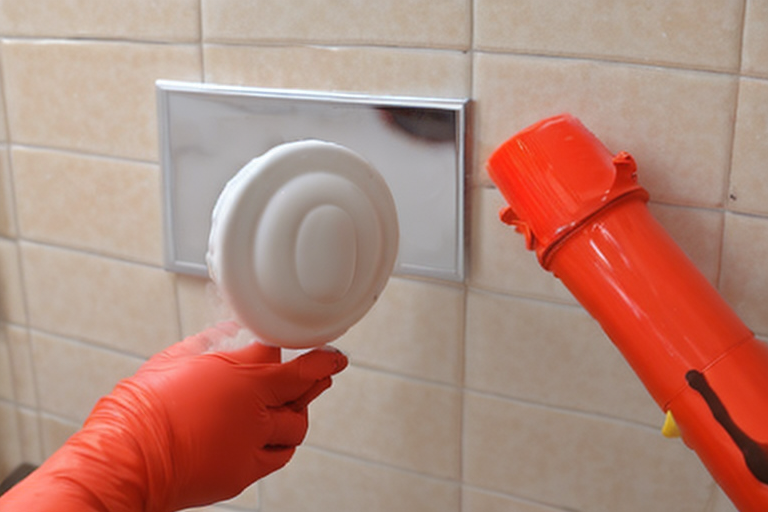Hello, homeowners and DIY enthusiasts! Have you ever encountered the puzzling challenge of wanting to remove your shower handle only to find yourself perplexed by the absence of those familiar screws? 88% of people find cleaning the bathroom a chore. 47% of homeowners seek fixtures that are easy to clean and maintain. It’s a common dilemma that can leave you scratching your head and wondering if you’ll ever get to the bottom of it. Fear not, for in this guide, we’re diving into the intriguing realm of removing shower handles without visible screws.
Whether you’re dealing with a modern shower faucet handle or an antique fixture, we’ve got you covered with the knowledge you need to conquer this task. Are you experiencing a clogged toilet situation? Say goodbye to frustration and hello to a newfound sense of accomplishment as we unravel the mystery and provide you with a step-by-step approach to smoothly and confidently achieving your goal. With our guidance, you’ll be able to tackle any obstacle and come out on top. So don’t hesitate, take control of your situation today and let us help you achieve success! So, let’s embark on this journey of discovery and unveil the secrets of how to take off shower handle that has no screws!
Understanding Your Shower Handle
The shower handle is the part of the shower faucet you use to control the water flow and temperature. It is connected to the shower valve, the part of the plumbing system that controls the water flow and temperature. The Great American Shower Study conducted by Delta Faucet revealed insights into Americans’ shower behaviors, which helped the company develop innovative products.
A longitudinal study found that the presence of bath aids, except for tub stools or bath chairs, hand-held shower sprays, long-handle brushes, or sponges, can lead to the development of bathing disability among community-living older persons. The shower valve is located behind the shower wall and is not usually accessible to the user.

Types of Shower Handles: A Quick Overview
Shower handles come in various forms, each with its unique attachment method. Let’s take a quick look at the types you might encounter:
- Traditional Screw-On Handles: The classic method involves screws that secure the handle to the valve stem.
- Snap-On Handles: These handles feature concealed screws hidden beneath a cover plate.
- Adhesive-Mounted Handles: Modern designs often use adhesive to attach the handle.
Identifying the Type
When removing your shower handle, it’s important to first identify what type of handle you have. This will help you determine the best method for removal, whether it’s a screw-on, snap-on, or adhesive-mounted variety. Once you’ve determined your handle type, you can proceed with the removal process. With the right tools and technique, you can easily remove your shower handle and replace it with a new one, creating a bathroom that reflects your personal style.
The Challenge of Screwless Handles: A Quick Note on Traditional vs. Modern Designs
Traditional screw-on handles are relatively straightforward to remove. However, modern screwless designs present a unique challenge. Without visible screws, you might wonder how to proceed. But worry not, as we’ll walk you through various methods to overcome this challenge with ease. Let’s, compare traditional and modern screwless shower handles:
| Feature | Traditional | Screwless |
| Construction | Metal or plastic with visible screws | Metal or plastic with no visible screws |
| Installation | Requires drilling holes in the shower wall | No drilling required |
| Durability | Can be more susceptible to damage from rust or corrosion | More durable and easier to clean |
| Appearance | More traditional look | More modern and sleek look |
| Price | Less expensive | More expensive |
Gathering Your Tools and Supplies
A successful removal process begins with the right tools at hand. Here’s what you’ll need:
- Flathead Screwdriver: Essential for prying open cover plates and manipulating components.
- Allen Wrench: Useful for handles secured with concealed hex screws.
- Adjustable Wrench: Handy for removing handles attached with nuts or retaining rings.
- Plumber’s Tape: Can help prevent scratches and provide a better grip.
- Hairdryer (For Adhesive-Mounted Handles): Required to soften adhesive bonds.
Before you start, protecting your shower’s surroundings is a good idea. Lay down a towel or plastic sheet to catch any small parts that might fall during removal. This precaution will help you avoid unnecessary cleanup afterward.
Method 1: Leveraging Hidden Screws

The screws are often cleverly concealed beneath a cover plate for snap-on handles. Here’s how to uncover and remove them:
- Prying Open the Cover Plate: Gently insert a flathead screwdriver under its edge and apply slight pressure to pop it open.
- Reveal and Remove the Hidden Screws: Once the cover plate is off, you’ll find the screws underneath. Use an appropriate tool (such as an Allen wrench) to remove them.
- Detaching the Handle from the Valve Stem: With the screws removed, the handle should easily slide off the valve stem.
Method 2: Applying Heat to Remove Adhesive-Mounted Handles

Modern shower handles often utilize adhesive for attachment. To remove them without causing damage, consider the following approach:
The Hairdryer Technique: Softening the Adhesive: Set your hairdryer to a low heat setting and aim it at the handle’s base for a few minutes. The heat will help soften the adhesive, making it easier to remove.
Be cautious not to overheat the handle or the surrounding area, as excessive heat can cause damage. Maintain a safe distance between the hairdryer and the handle to prevent any mishaps.
Method 3: The Art of Handle Jiggling

For handles that seem impossibly stuck, the handle-to-stem connection might just need a little nudge:
- Rocking the Handle Gently: Hold onto the handle and gently rock it back and forth. This motion can help loosen any grip causing the handle to stick.
- Wiggling the Handle in Different Directions: Try wiggling the handle up and down and side to side. The combined movements can gradually break the hold.
Method 4: Wrapping Up for Success

If the handle is still proving stubborn, a simple rubber band can make all the difference:
Twisting with Ease: Place a rubber band around the valve stem where the handle attaches. This added traction can make it easier to twist and remove the handle.
Method 5: Harnessing the Power of Lubricants

Lubricants can be surprisingly effective in easing the removal process. Let’s explore this approach:
Applying the Lubricant: A Step-by-Step Guide to Smooth Removal: Apply a small amount of your chosen lubricant to the area where the handle meets the valve stem. Allow it to seep in for a few minutes to help loosen the bond.
Common Challenges and Solutions
Sometimes, screws can be rusted or stuck due to prolonged exposure to water. In such cases, penetrating oil can work wonders:
Understanding the Hidden Challenge
The Enigma of Hidden Screws
Though seemingly straightforward, shower handles often conceal their attachment secrets beneath a layer of aesthetics. Many modern shower fixtures are designed to maintain a sleek and seamless appearance, often opting for concealed screws to avoid disrupting the visual appeal. This clever design can pose a significant challenge when dismantling the handle for repairs or replacements.
Why Removing Without Screws Matters
You might wonder why the absence of visible screws is a concern. Removing a shower handle incorrectly can lead to irreversible damage to the fixture, and that’s not a situation anyone wants to deal with. The lack of exposed screws can lead to frustration, but fear not – there are solutions at hand.
Solution 1: Investigate for Set Screws
Hidden screws are not always as covert as they might seem. Some shower handles utilize set screws strategically placed beneath subtle caps or covers. These caps are often near the base of the handle, designed to blend seamlessly with the overall design. Grab a flashlight and inspect your handle carefully, looking for these hidden compartments.
Solution 2: The Power of Pry Tools
When all else fails, it’s time to embrace the power of pry tools. These nifty tools can be carefully inserted between the handle and the wall, allowing you to pry the handle off its attachment points gently. However, this method requires precision and patience to avoid causing any damage to your beloved shower fixture.
Solution 3: Threaded Adapters
In some cases, your shower handle might be secured through threaded adapters instead of visible screws. These adapters provide a secure connection between the handle and the valve stem. To remove the handle, you must rotate it counterclockwise while exerting steady pressure. The threads should disengage, allowing you to lift off the handle.
Solution 4: Seek Professional Help
If tackling your shower handle’s mystery is a bit overwhelming, don’t hesitate to seek professional assistance. A seasoned plumber or handyman can quickly assess the situation and apply the appropriate methods to safely remove the handle without causing any harm.
Preventing Future Frustrations
Document the Process
As you successfully navigate the challenges of removing your shower handle, consider documenting the process for future reference. Take clear photographs of each step and keep a detailed record of the solutions you employed. This proactive approach will save you time and effort if you face a similar situation.
Regular Maintenance
To avoid the stress of removing a handle with hidden screws, it’s wise to engage in regular maintenance. Periodically inspect your shower fixtures, looking for signs of wear or damage. By addressing issues early on, you can prevent the need for emergency removals and keep your bathroom in tip-top shape.
Troubleshooting and Expert Tips

If you struggle despite your best efforts, don’t hesitate to seek professional assistance. A skilled plumber can swiftly resolve the issue.
Troubleshooting
If you’re having trouble removing your shower handle, here are a few troubleshooting tips:
- Make sure that you’re turning off the water supply to the shower.
- Check to see if any hidden screws are holding the handle in place.
- Use a stronger wrench if the setscrew is not budging.
- Be careful not to pry too hard, as you could damage the handle or the wall.
Expert Tips
Here are a few expert tips for removing a shower handle without screws:
- Use a strap wrench if you have one. A strap wrench is a tool that can apply a lot of torque without slipping.
- You can try heating the handle with a hair dryer if it is plastic. This will make the plastic more flexible and easier to remove.
- If all else fails, you can call a plumber. A plumber will have the tools and experience to remove even the most stubborn shower handles.
Conclusion
As you stand before your shower, perplexed by the absence of visible screws holding that handle in place, a sense of frustration creeps in. The problem isn’t just the handle—it’s the barrier it presents to your bathroom upgrade. But fear not, for there’s a smarter approach. You’re equipped with a fresh perspective by delving into removing shower handles without visible screws.
Picture the satisfaction of smoothly operating faucets devoid of those elusive screws. Embrace the intrigue of discovering an unconventional solution, and bid farewell to the days of puzzling over a seemingly immovable fixture. With the ingenious techniques explored, the solution is in your hands—literally. So bid adieu to the screws and say hello to a shower transformed, all thanks to your newfound expertise.
FAQs
Q: Can I use any type of lubricant for removing adhesive-mounted handles?
A: While some lubricants can work, it’s best to use silicone or WD-40 due to their effectiveness and compatibility with bathroom environments.
Q: How can I prevent screws from rusting in the first place?
A: Applying a layer of clear nail polish or anti-rust spray on screws can help prevent rust formation.
Q: Is it safe to use a hairdryer near my shower?
A: Yes, it’s safe if you use it responsibly and keep a safe distance to avoid overheating.
Q: What if I accidentally damage the handle during removal?
A: If the handle gets damaged, you can explore replacement options either from the manufacturer or your local hardware store.
Q: Can I reuse the removed handle after cleaning it?
A: Reusing a handle is possible, but ensuring it’s still in good condition and hasn’t sustained any damage during removal is essential.
Tags: How to, Remove Shower Handle, Screws



